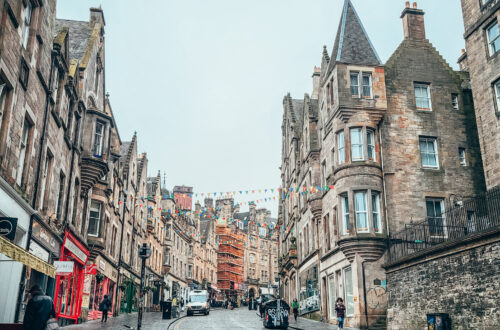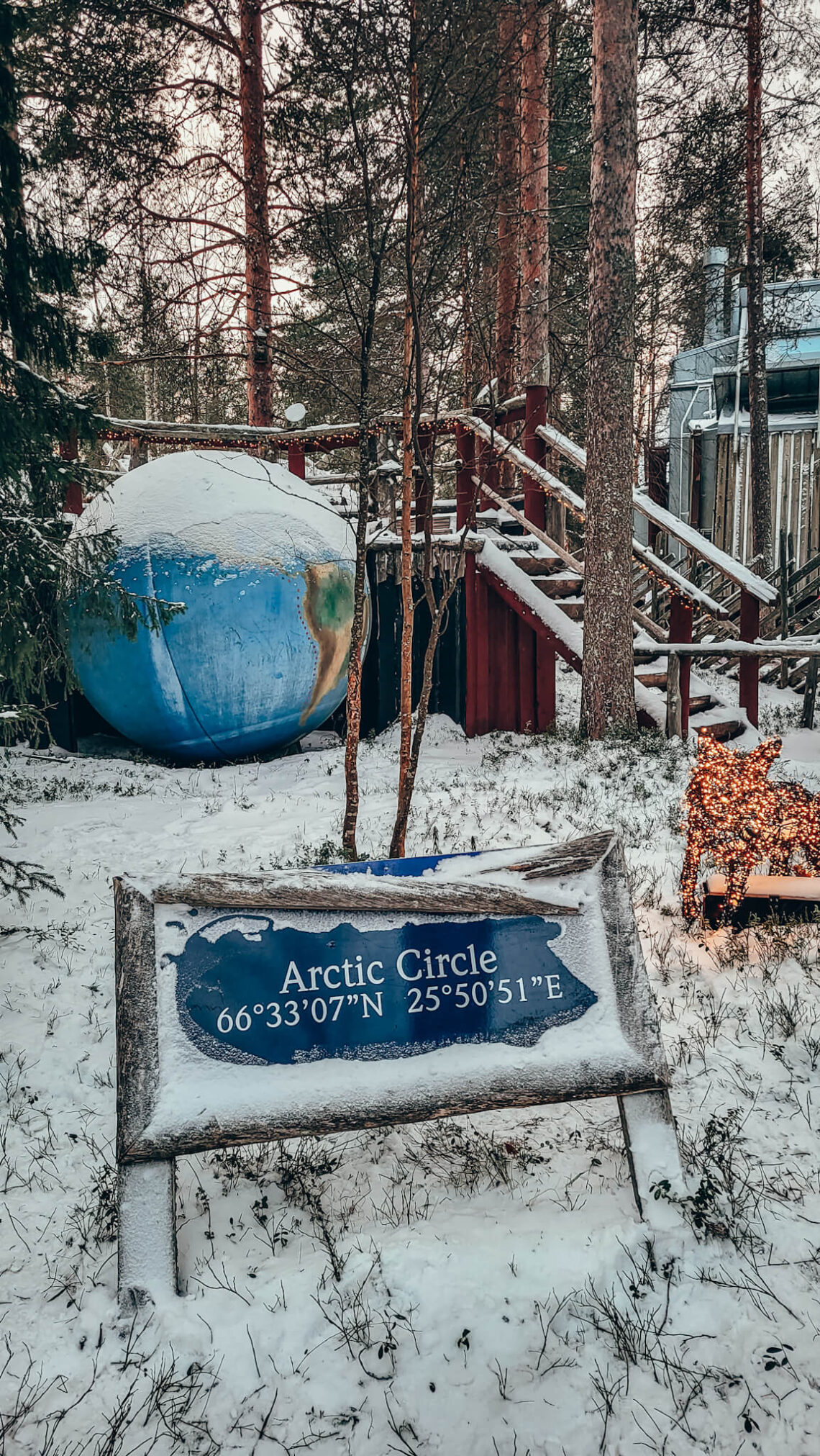
Rovaniemi, Lapland: Northern Lights. And Other Practical Information
Some posts on this website contain affiliate links. I receive a small commission if you use the links at no extra cost to you.
This post begins a series of articles about the stunning Finnish Lapland, more specifically about Rovaniemi, the capital of the region.
The articles will answer many questions and help you organize your Lapland trip. If you are still wondering or are already planning a trip to Rovaniemi, read on for many useful tips.
In this post, I will focus on a very important topic, so the Northern Lights in Rovaniemi.
How and where to see it? What apps to use?
And on practical information about a trip to Lapland: when to go, how much time to spend, etc.
Basic information about Rovaniemi
Rovaniemi is the largest city in the Finnish part of Lapland (it has about 60,000 inhabitants). It’s the capital of the region: administrative, economic, cultural, it is also home to the University of Lapland and the airport. The Arctic Circle line runs through the area of the airport and Santa Claus Village.
Rovaniemi is an increasingly popular tourist destination. The city is known primarily for Santa Claus Village, but in the posts, I will describe many other places and attractions worth seeing and doing during your stay in Rovaniemi.
How much time to spend in Rovaniemi
I know that short weekend or even one-day trips are quite popular. Then, visitors mainly focus on visiting Santa Claus Village or Santa Park.
A visit to the Village is of course an important point of the Rovaniemi travel program. You can’t miss it, even if the trip is only for adults. However, Rovaniemi and the surrounding area is not just the Village. It is mainly about the amazing nature and views.
That’s why I think you should definitely have some time to explore the area. It’s really worth spending at least 4 days here, which will give you more time for various attractions and experiences and increase your chance of seeing the aurora.
(You can also plan a longer visit, you won’t be bored. But of course this involves higher costs).
When to go to Rovaniemi
The official tourist organization promotes Rovaniemi as a year-round destination. And I think that’s true, because every season will be different and beautiful here.
It’s worth thinking about a visit in summer, because of the warmer temperatures, long days and beautiful colours of the polar day (midnight sun).
And above all, it’s worth thinking about a visit in winter. Winter means frost (sometimes very heavy), snow, aurora borealis and Christmas season. It’s also the highest season, the biggest crowds and the highest prices. The most popular and expensive time is of course December.
And for that reason, I would advise avoiding December.
Does it sound a bit controversial? Let me explain why.
A trip to Rovaniemi had been on my mind for some time, but this year’s trip was spontaneous, organized about 2 weeks before departure (travel time was between November 21st-27th).
Also because I noticed that ‘it really pays off now’. The prices for the train and accommodation were much lower, compared to the prices for the same services and places in December.
The flat we spent 3 nights in a week later would cost almost… 3 times as much.
That’s why I think the end of November is a good time: it’s already wintery and festive, but not so crazy in terms of crowds and prices.
Of course, it also has its disadvantages: there’s no certainty about the weather or snow (there never is, but there’s a bigger chance of no snow. On the other hand, there’s also not as much frost and coldness). Many attractions and trips are only starting, and you won’t be able to visit them, for example, a snow hotel or Snowman World.
January and February are very wintery and frosty, which has its advantages.
March would also be a good idea.
Polar day and night
The phenomenum of polar day and night only occur beyond the Arctic Circle. Polar day is in summer, when the sun practically does not set, polar night in winter, when it practically does not rise. The number of days when you can experience this phenomenon depends on your location. The higher, further beyond the circle, the more.
As Rovaniemi lies on the border of the Arctic Circle, there is no long polar night here in the strict sense. But the day lasts a maximum of 2 hours (so it has practically the colours of the sunset all the time).
In Ivalo, which is further north (about 300 km beyond the circle), this season the polar night began on 03.12 and will end on 07.01.
During the polar night it is not completely dark, more like gray-blue.
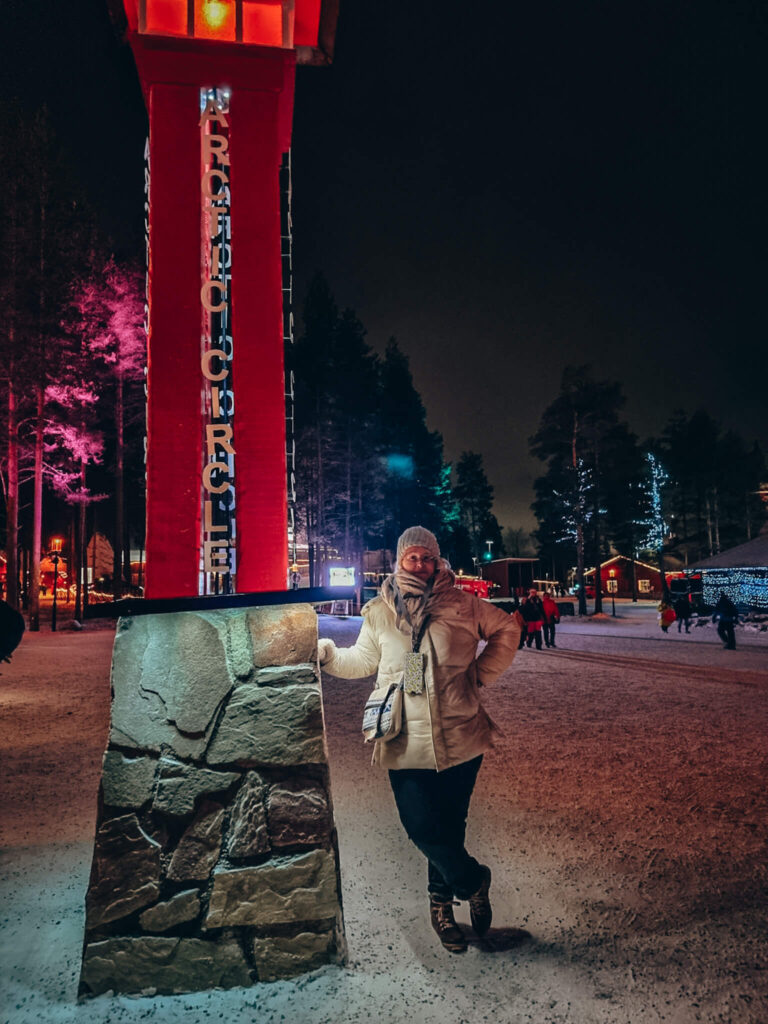
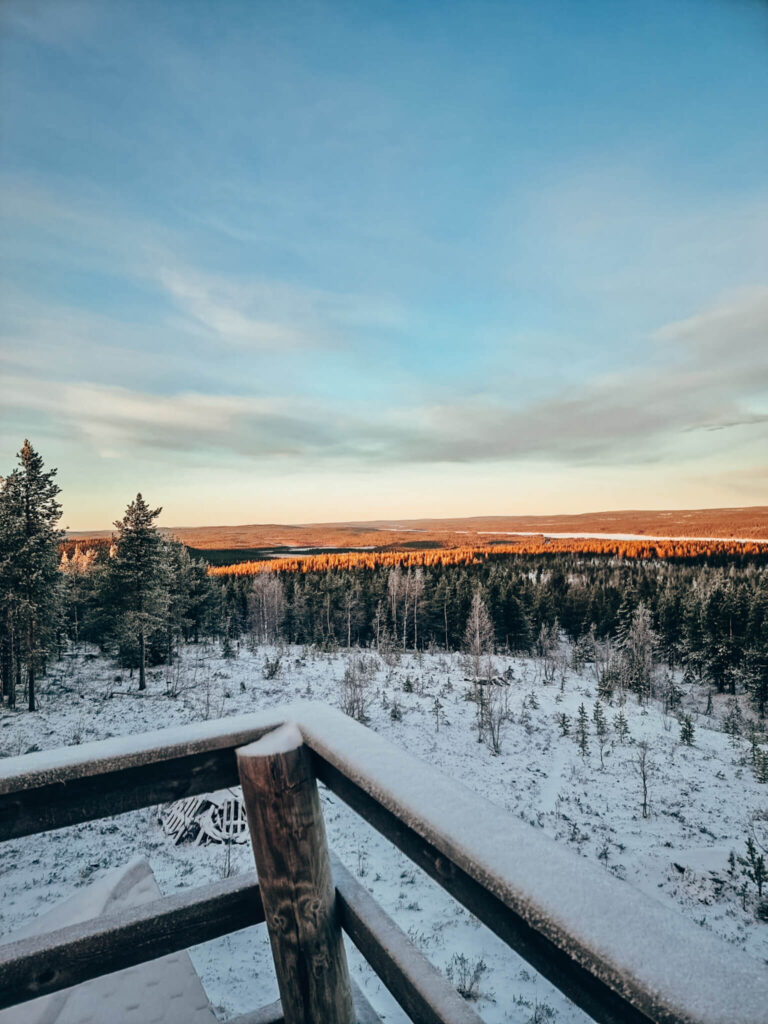
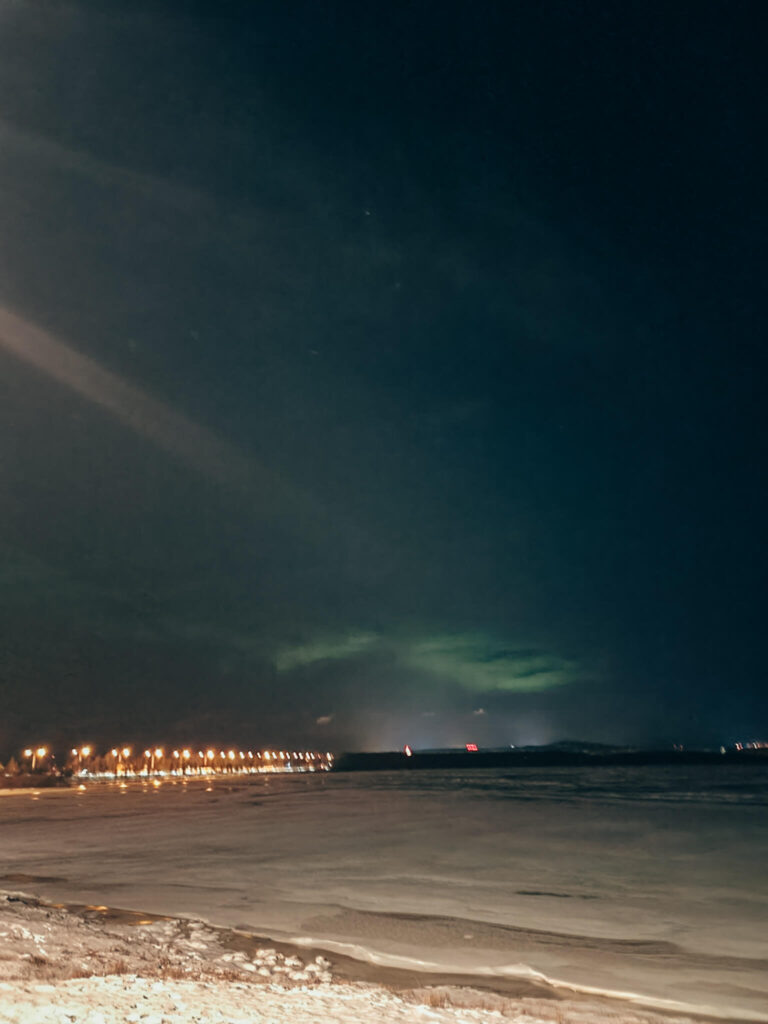
Northern Lights in Rovaniemi
Let’s move on to my favourite topic, the Aurora Borealis. After Santa Claus, the aurora is probably the second most important thing for all tourists visiting the region.
Finnish Lapland, including Rovaniemi, is a great region to see the aurora due to its location. Of course, it’s not like you’ll see the aurora every time you’re in Rovaniemi. It requires a few factors meeting at the same time:
• appropriate aurora activity,
• clear, cloudless sky,
• darkness.
The Aurora Borealis is also another reason to stay in Rovaniemi a little longer. The longer you stay, the greater the chance that all these factors will come into play at the same time.
I wrote a little more about the aurora phenomenon and how to hunt it in this post. This bit of information may be useful, regardless of whether you’re looking for the Aurora Borealis yourself or going on a ‘hunt’ with a guide.
The most important thing: if you want to see the aurora, plan your trip between August/September and March/April at the latest. From the second half of April to August, it is usually just too bright for the aurora.
Hunting for the aurora with a guide
I wrote about the aurora hunting trip here. The post was based on my experiences in Tromso, Norway.
Also in Rovaniemi, one of the most popular attractions is the Aurora Hunting Trip with a Guide. I still think it’s a great idea, especially if you don’t rent a car.
The guides will take you to remote, dark places, where catching the aurora will be much easier (and your pictures will be more beautiful and greener:). In addition, the guides often take photos with better equipment, light a bonfire, etc., it all creates great atmosphere.
In Rovaniemi, you will also find many offers of ‘combined’ trips. These include snowmobiles, ice floating, a dog sleds ride with huskies, snowshoes, etc., which take place in the evening, in the darkness outside the city. Then you have a chance to see the aurora.
Look for such several-hour trips primarily on GetYourGuide, you will find most companies there.
You can also cancel most of your reservations up to 24 hours in advance on this portal, so it’s a pretty safe way to make a reservation.
Hunting for the aurora: Apps
A good chance to catch the aurora you will have if you spend the night in resorts located far from the city, such as yurts or igloos. Very often in such places you can even ask for wakeup call when the aurora appears.
However, the chance for the aurora is also at nights when you do not travel far from the centre. It all depends on the conditions.
So always keep your eyes open. And have the internet connected, because using different apps will be very useful.
There are several apps that show you the conditions and the chance for the aurora, and also send alerts. It is worth using them.
The most famous is the Aurora app. It shows KP or live cameras, it can be really useful. I used this app during my Tromso trip.
There are also more local apps focusing on the Finnish Lapland region.
The first is the local NL Alert app, which is used by some hotels and resorts. I didn’t use the paid alert option, but I was checking their cameras and forecast.
In Rovaniemi, I used the Aurora Alert-Realtime app. It’s a free app where you choose the areas around Rovaniemi for which you want to receive an alert.
Aurora in the centre of Rovaniemi
The app also sends alerts to Rovaniemi-City, and in my case it worked great. After receiving the alert, we quickly went to the river bank and after a short time the aurora was visible.
In the centre of Rovaniemi, the best place to see the aurora is from the garden by Arktikum, but you don’t really have to go that far. You can go to the river, head towards Arktikum and be sure to pass the bridge, whose lights are disturbing. After the bridge, the conditions should be sufficient to spot the aurora.
There is something magical about seeing the aurora, it’s hard to describe. Something that makes you want to see it more and more often.
I hope you will be lucky with the conditions during your stay!
How to get to Rovaniemi
Rovaniemi, due to its (growing) popularity, is really accessible. We have several options for getting there.
There are one-day charters, for example from the UK. There are also direct flights from a few European airports, with standard airlines or low-cost airlines, like Ryanair from London.
You can fly there with a transfer via Helsinki with FinnAir.
Another option is to fly to Helsinki or Turku and travel by train or bus to the north.
The train is quite a popular and very pleasant option (which can also be quite budget-friendly option). This is the option also I recommend, because that’s how I got to Lapland and it was really great trip.
Here you can read about details of every travel option.
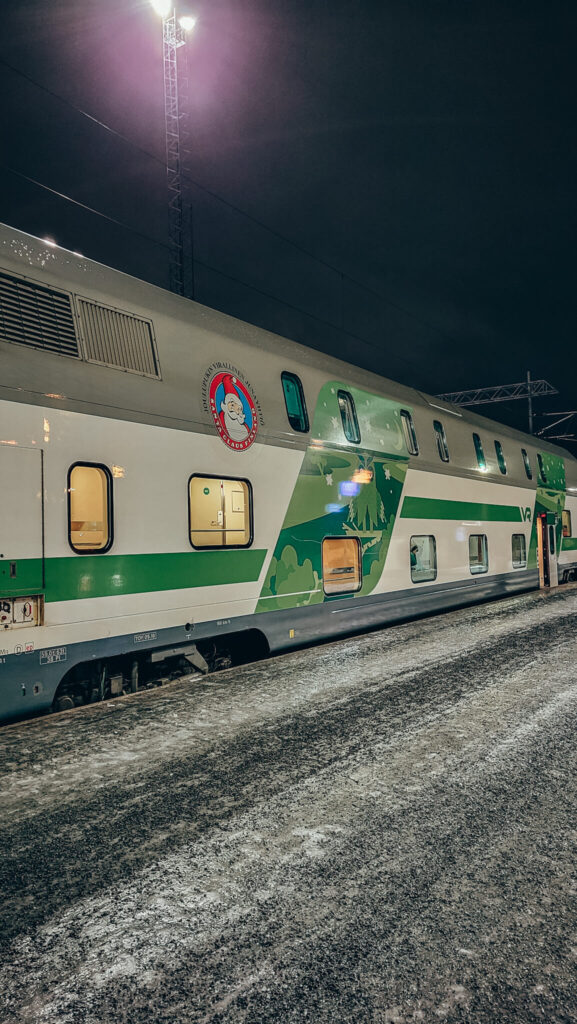
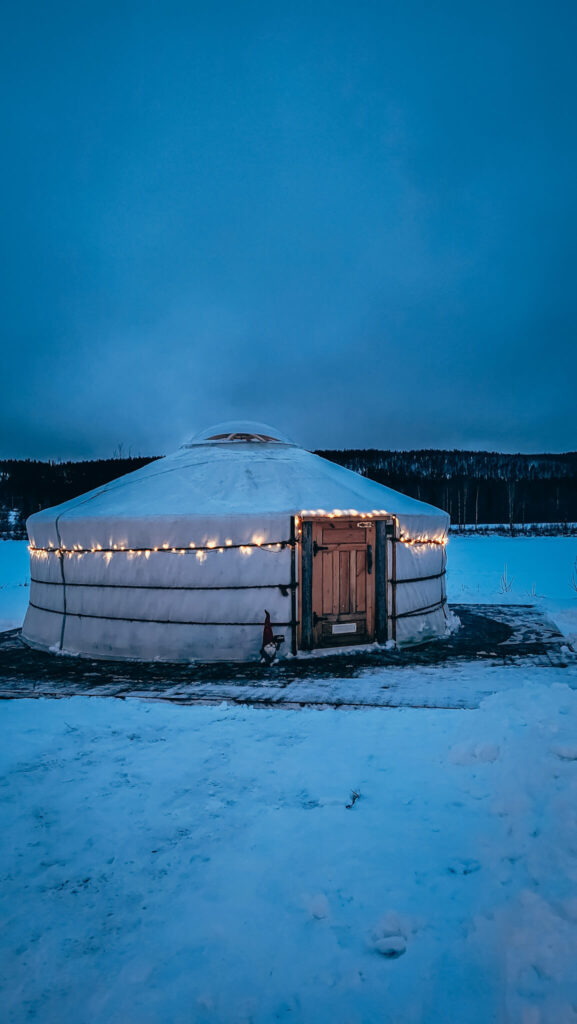
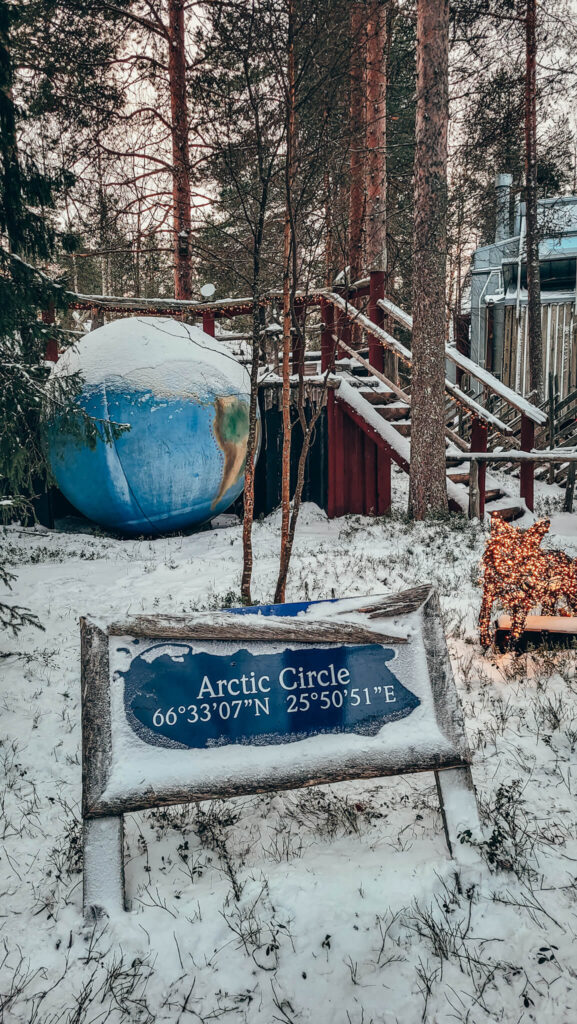
Where to sleep in Rovaniemi
Both Finland and Rovaniemi are not the cheapest when it comes to accommodation. But as I wrote earlier, it also depends on the date of your trip.
It is a tourist region, so you will find many accommodation options here. However, it is worth booking in advance, because some, the most interesting or most affordable ones, sell out quickly.
Roughly speaking, you have two options: to stay in Rovaniemi itself or outside the city.
There are hotels, hostels and many private flats available in the city, which are also worth having a look at. The advantage of living in the city is easier logistics and usually lower prices.
The option of living outside the city, often by the river, in the forest, in cottages or even in modern igloos may be a bit more difficult logistically and more expensive, but beautiful, and can be great experience.
Accommodation that I can recommend
You can also combine these accommodation types. Just like during my trip: we slept 3 nights in a great apartment in the centre of Rovaniemi, and 1 in yurts by the river about half an hour’s drive from the city.
I highly recommend both of them:
Apartment on the main street, a short walk distance to the main square, but in a quiet and peaceful area. It was a studio with a kitchenette, large balcony, and a bathroom with a sauna, which could be used for free. Very nicely decorated, in Nordic style and very cozy.
Yurts right by the river, in the middle of nowhere (in the good sense of the word). Very nice owners, everything is very well organized. Yurts are warm inside (there are radiators), beautifully decorated, with a glass part of the roof.
The bathrooms are shared, in a separate small building (you have to go out to them from the yurt), but clean and modern.
Amazing place, one of the best I’ve slept in during my many trips in recent years.
Currency, language, time zone
Let me give some more formal information to complete the topic. Finland is a member of the European Union (and the Schengen Area), and the currency in the country is the Euro (it is worth remembering it, as in the other Nordic countries the currency is krona).
The time zone is Eastern European Time, which means that in Finland it is ‘an hour later’ than in Paris or Berlin, and ‘two hours later’ than in London.
Languages
The language is Finnish, and it can definitely be said that it is a difficult language. It is not a language belonging to the Scandinavian group, but to the Finno-Ugric group (together with Hungarian and Estonian).
The second official language is Swedish, which is why, for example, on the train you will also hear announcements in Swedish.
The Finno-Ugric group also includes the Sami languages (so Lapland region languages), which are additionally divided into three groups. Their similarity to Finnish is quite distant.
The languages currently have small groups of speakers. Various activities are undertaken to teach and maintain languages, for example in schools and kindergartens. You can learn a bit about this topic by visiting the exhibition at Arktikum in Rovaniemi.
Of course, you will not have the slightest problem communicating in English.
Rovaniemi Practical Information: Summary
I hope this article has given you useful tips. And it has also shown, even just looking at the practical information, how interesting this region is.
In the posts I focus on Rovaniemi, because this is the place where most tourists go, but obviously much of this information will also work if you are going to other places in Finnish Lapland, e.g. Ivalo.
More posts on Rovaniemi you can find here. Welcome!




